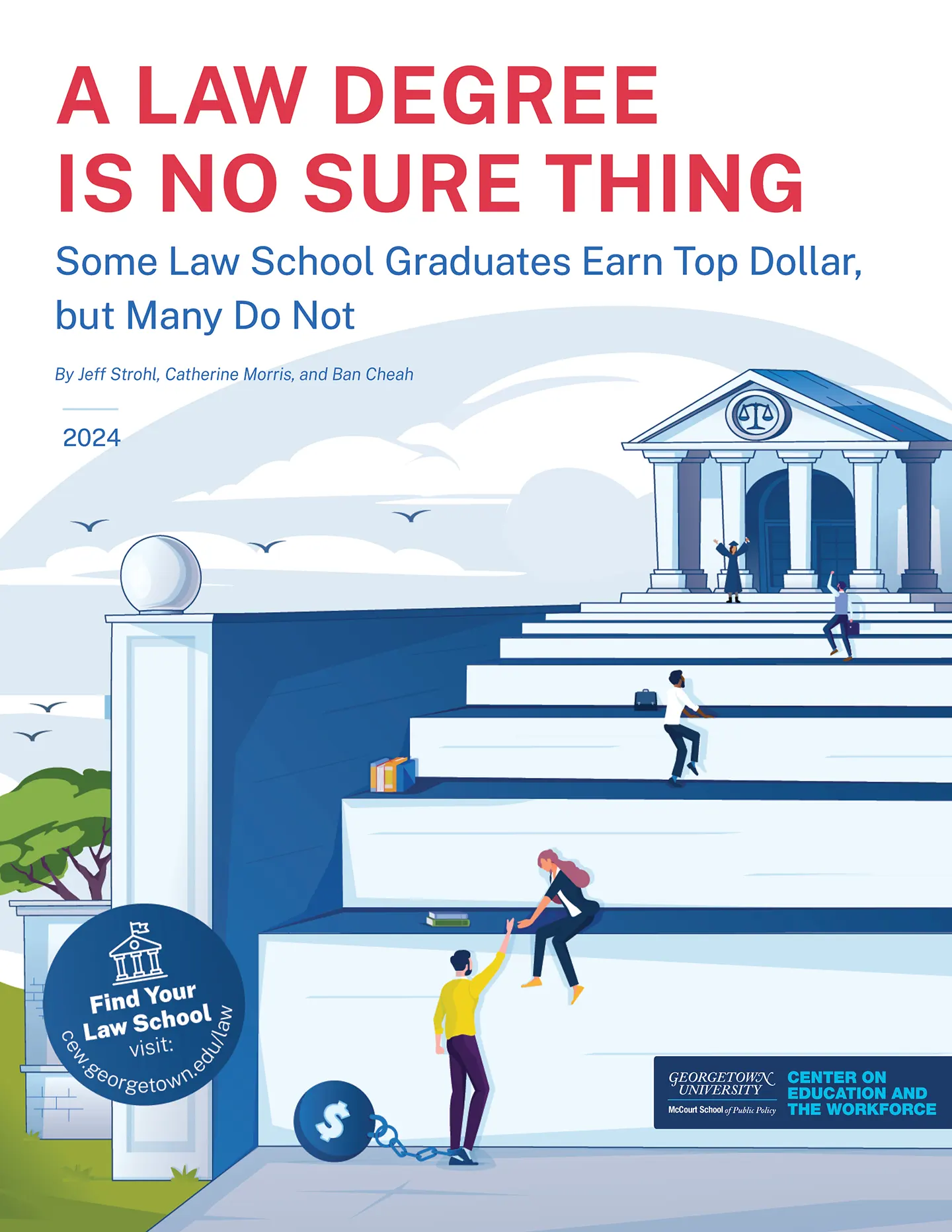Summary
Is law school worth it? A Juris Doctor (JD) offers high median earnings and a substantial earnings boost relative to a bachelor’s degree in the humanities or social sciences—two of the more common fields of study that lawyers pursue as undergraduate students. However, graduates of most law schools carry substantial student loan debt, which dims the financial returns associated with a JD.
A Law Degree Is No Sure Thing: Some Law School Graduates Earn Top Dollar, but Many Do Not finds that the return on investment (ROI) in earnings and career outcomes varies widely across law schools. The median earnings net of debt payments are $72,000 four years after graduation for all law school graduates, but exceed $200,000 at seven law schools. By comparison, graduates of 33 law schools earn less than $55,000 net of debt payments four years after graduation.
Find Your Law School
To see how your law school stacks up, explore our sortable table of 186 law schools ranked by ROI metrics, including median monthly debt payments, median annual earnings, and median annual earnings net of debt payments.
– Median Monthly Debt Payments
Monthly debt payments are based on data from the College Scorecard. Note that these data only include federal student loans and do not capture loans from other entities such as institutions, states, or private lenders.
– Median Annual Earnings
Earnings refer to graduates’ median yearly earnings four years after graduation.
– Median Annual Earnings Net of Debt Payments
This dollar figure represents graduates’ annual earnings net of debt payments four years after they graduate from law school. We take debt payments into account in addition to earnings because a significant debt load can offset high earnings.
Source: Georgetown University Center on Education and the Workforce analysis of data from the US Department of Education, College Scorecard, 2023.
Note: When computing monthly loan payments, the Department of Education assumed a 10-year repayment period and an interest rate of 7.54 percent for graduate programs.
Student Loan Debt
High debt levels can negatively affect the financial returns of a law degree. Law school graduates accumulate a median of $118,500 in debt in the pursuit of their degree, which translates to high monthly loan payments for graduates of many schools. However, lower earnings and lower debt payments do not necessarily go hand-in-hand: at some institutions where graduates have the lowest earnings, monthly debt payments exceed or match those of graduates from law schools with the highest earnings.
Source: Georgetown University Center on Education and the Workforce analysis of data from the US Department of Education, College Scorecard, 2023.
Note: When computing monthly loan payments, the Department of Education assumed a 10-year repayment period and an interest rate of 7.54 percent for graduate programs.
Gender and Race/Ethnicity
Law schools have become increasingly diverse; however, disparities in earnings persist by race/ethnicity and gender. For example, since 2016, women have outpaced men in law school enrollments, accounting for 56 percent of all law school students in 2023. Nevertheless, women are underrepresented in the legal profession: women account for only 39 percent of all practicing lawyers. Additionally, among working lawyers, ages 25–54, the gender pay gap favors men by $28,000: female lawyers earn a median of $113,000 while male lawyers earn $141,000.
Earnings vary by race/ethnicity as well. Asian American lawyers, ages 25–54, have the highest median earnings ($132,000), followed by white ($131,000), multiracial ($125,000), Hispanic/Latino ($113,000), and Black/African American lawyers ($108,000).
Source: Georgetown University Center on Education and the Workforce analysis of data from the US Census Bureau, American Community Survey (ACS), 2009–19.
Note: This analysis is based on 25-to-34-year-old, 35-to-54-year-old, and 25-to-54-year-old lawyers working full-time, full-year. American Indian/Alaska Native/Native Hawaiian/Pacific Islander (AI/AN/NH/PI) lawyers are not included in this analysis due to small sample size.
Bar Passage
Passing the bar exam is a critical step before law graduates can become practicing lawyers. In 2022, 78 percent of first-time test takers passed the bar exam, and the two-year bar passage rate was 92 percent. Law schools with higher median earnings net of debt payments for graduates generally have higher bar passage rates, while law schools with lower earnings net of debt payments for graduates tend to have the lowest bar passage rates. For example, the first-time bar passage rate in 2022 was 91 percent at law schools where net median earnings exceed $100,000 four years after graduation. By comparison, at law schools where net median earnings are less than $55,000 four years after graduation, the average first-time bar passage rate was 59 percent.
Source: American Bar Association, Section of Legal Education and Admissions to the Bar, 2023; Georgetown University Center on Education and the Workforce analysis of data from the US Department of Education, College Scorecard, 2023.
Resources
A Law Degree Is No Sure Thing: Some Law School Graduates Earn Top Dollar, but Many Do Not finds that not all law schools result in comparable outcomes.


